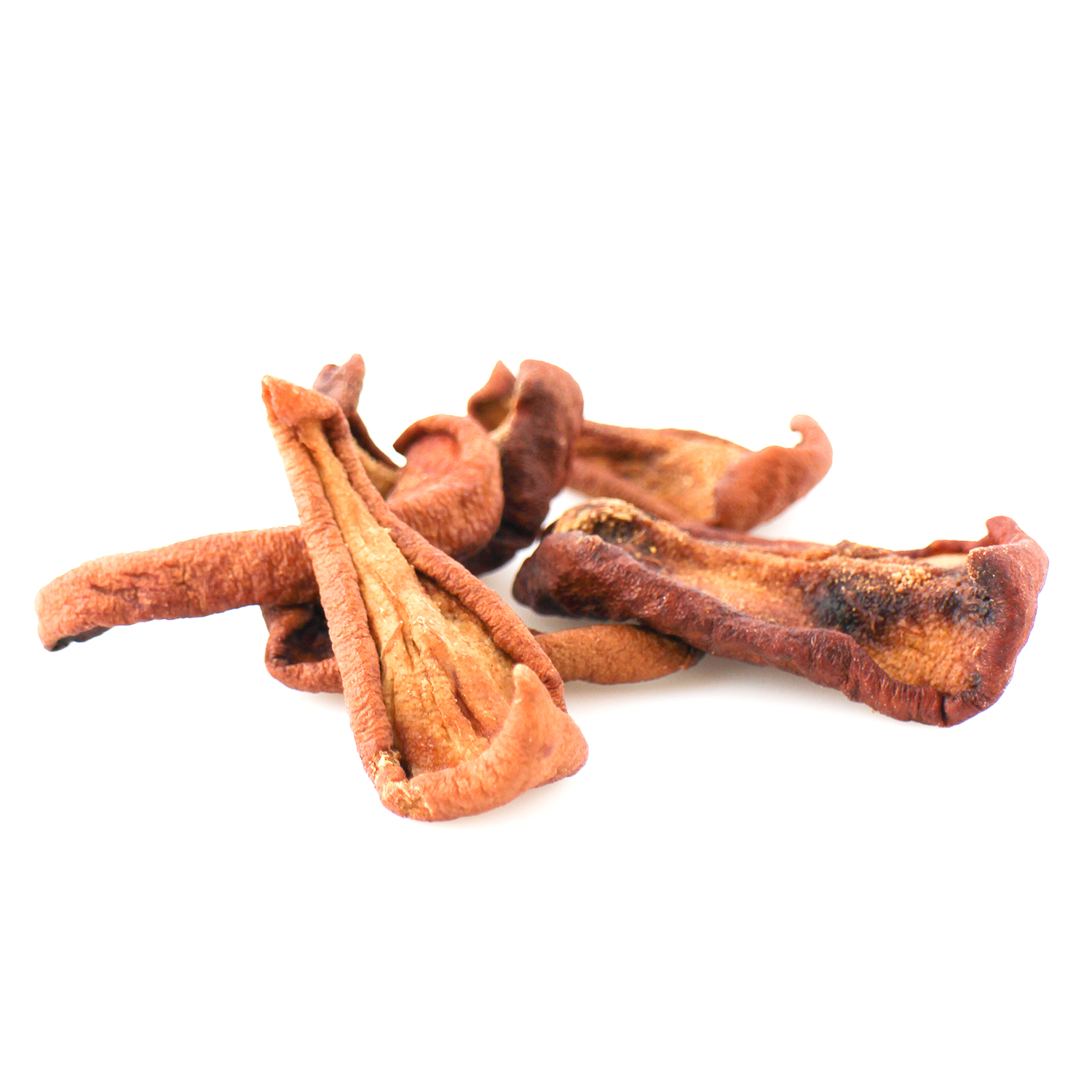
The pear tree is a medium-sized tree from the Rosaceae family. It is grown for the fruit, the pear, which can be found in all seasons on the shelves. Pears are eaten raw, cooked or dried. Drying produces a high concentration of its compounds, including sugars (carbohydrates). Carbohydrates are essential for the body to function. Alongside sugars, dried pears are rich in fiber, which contributes to digestive comfort and reduces the absorption of cholesterol. Finally, the antioxidant capacity of dried pears is quite high. Something to do good for the body and taste buds. Latin name: Pyrus communis L. Botanical family: Rosaceae. Part used: Fruit.
Recommended consumption
Dried pear is a dried fruit. It therefore contains more sugar than a fresh pear, the daily consumption recommendations are defined. As a classic treatment or for pleasure, a portion of dried pear is estimated between 20 and 30 g per day, which represents 3 to 5 strips per day.
In what form ?
To make the most of their benefits, you can use them:
- Whole
- In pieces
At what time of the day ?
We advise you to use them during the following meal(s) to make the most of their benefits:
- Breakfast
- Lunch
- In case
- Dinner
What methods of use?
You can include them in the following preparations to make them easier to take:
- Dessert
- Yogurt, dairy
- Alone
- Mixed with other dried fruits
Health nutrition benefits
Digestive system
Constipation is often synonymous with a diet deficient in fiber (see our guide on constipation and diet). Dried pears contribute to dietary fiber intake. Thus, they can claim to help the return of normal digestive transit.
Metabolism
Dried pears are rich in fiber. Fiber reduces the bioavailability of other food constituents, such as cholesterol. Thus, they help regulate cholesterol levels. In addition, dried pears help prevent cardiovascular complications. Indeed, through their antioxidant powers, they moderate cholesterol peroxidation (a factor in the appearance of atherosclerotic plaques). As a result, dried pear helps prevent the harmful effects of oxidative stress and hypercholesterolemia, to be integrated into a varied and balanced diet.
Nervous system, well-being
Carbohydrates are our cells' preferred macronutrients for energy. Particularly for glucose-dependent cells, such as cells of the nervous system. Dried pears provide carbohydrates, allowing the body to meet its needs.
Nutritional properties
-
Contributing to energy metabolism (carbohydrate): dried pears are energy dense. This energy is mainly carbohydrate. Fructose would be the first sugar that constitutes Pears, followed by sucrose and glucose. These fuels are easily used by cells.
-
Anti-oxidant : Dried pears are vectors of antioxidant compounds. Their ORAC score is estimated at 4222 µmol TE/100 g, which represents a very high antioxidant capacity. They neutralize free radicals resulting from the normal functioning of cells.
-
Laxative (fiber): dried pears are rich in soluble fiber. Fiber cannot be absorbed by the body, so it goes directly into the stool. The fibers swell on contact with water, this increases the volume of stools and accelerates intestinal transit.
-
Hypocholesterolemic (fiber): due to their richness in fiber, dried pears reduce the absorption of dietary cholesterol.
Nutritional values
| Nutritional elements | per 100g | for 25g | % of RDA* per 100 g | % of RDA* for 25 g |
| Energy (Kcal) | 340 | 85 | 17 | 4 |
| Energy (Kj) | 1423 | 356 | 17 | 4 |
| Lipids (g) | 0.22 | 0.05 | 0 | 0 |
| Saturated fatty acids (g) | 0.07 | 0.01 | 0 | 0 |
| Carbohydrates (g) | 82.16 | 20.54 | 32 | 8 |
| Including sugars (g) | 42.4 | 10.6 | 47 | 12 |
| Dietary fiber (g) | 11.4 | 2.85 | ||
| Protein (g) | 2.29 | 0.57 | 5 | 1 |
| Salt (g) | 0 | 0 | 0 | 0 |
*recommended daily allowance
Learn more about the plant: The Pear Tree
The pear tree belongs to the large Rosaceae family. Before settling in Europe, the pear tree originated in Asia. It is a medium-sized tree, 10 to 15 m high. It can live up to 200 years. The pear tree has oval leaves, with a petiole longer than the blade. The flowers are white, have five petals and are hermaphroditic. The fruits are large, obovate fruits, well known in France: Pears. The pear tree tolerates slightly bright, continental climates and neutral to weakly acidic soils. It grows in hedges and woods of low mountain plains.
It is found throughout France, although it is rarer in the Mediterranean region. Furthermore, there are more than 2,000 varieties, some of which fruit in winter and others in summer. The pear tree is grown for its fruit, which is the sixth most consumed fruit by the French, with 4.7 kg per year per purchasing household. The pear would already be consumed in Ancient Rome raw, cooked or dried.
Was this article helpful to you?
Average grade: 3.5 ( 2 votes)
Bibliography
Work : Pouyat-Leclère, J. (2013). Guide to Antioxidant Foods. Thierry Souccar Editions & La Nutrition.fr
Website : Pear: calories and nutritional composition. (nd). Aprifel. https://www.aprifel.com/fr/fiche-nutritionnelle/Poire/


